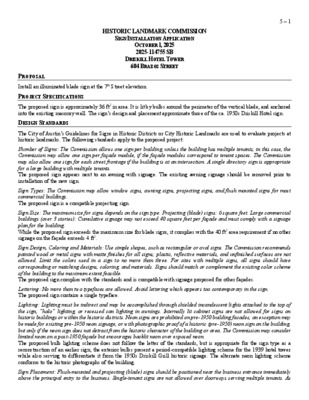05.0 - 604 Brazos St — original pdf
Backup

HISTORIC LANDMARK COMMISSION SIGN INSTALLATION APPLICATION OCTOBER 1, 2025 2025-114755 SB DRISKILL HOTEL TOWER 604 BRAZOS STREET 5 – 1 PROPOSAL Install an illuminated blade sign at the 7th Street elevation. PROJECT SPECIFICATIONS The proposed sign is approximately 36 ft2 in area. It is lit by bulbs around the perimeter of the vertical blade, and anchored into the existing masonry wall. The sign’s design and placement approximate those of the ca. 1950s Driskill Hotel sign. DESIGN STANDARDS The City of Austin’s Guidelines for Signs in Historic Districts or City Historic Landmarks are used to evaluate projects at historic landmarks. The following standards apply to the proposed project: Number of Signs: The Commission allows one sign per building, unless the building has multiple tenants; in this case, the Commission may allow one sign per façade module, if the façade modules correspond to tenant spaces. The Commission may also allow one sign for each street frontage if the building is at an intersection. A single directory sign is appropriate for a large building with multiple tenants. The proposed sign appears next to an awning with signage. The existing awning signage should be removed prior to installation of the new sign. Sign Types: The Commission may allow window signs, awning signs, projecting signs, and flush mounted signs for most commercial buildings. The proposed sign is a compatible projecting sign. Sign Size: The maximum size for signs depends on the sign type. Projecting (blade) signs: 6 square feet. Large commercial buildings (over 3 stories): Cumulative signage may not exceed 40 square feet per façade and must comply with a signage plan for the building. While the proposed sign exceeds the maximum size for blade signs, it complies with the 40 ft2 area requirement if no other signage on the façade exceeds 4 ft2. Sign Design, Coloring and Materials: Use simple shapes, such as rectangular or oval signs. The Commission recommends painted wood or metal signs with matte finishes for all signs; plastic, reflective materials, and unfinished surfaces are not allowed. Limit the colors used in a sign to no more than three. For sites with multiple signs, all signs should have corresponding or matching designs, coloring, and materials. Signs should match or complement the existing color scheme of the building to the maximum extent feasible. The proposed sign complies with the standards and is compatible with signage proposed for other façades. Lettering: No more than two typefaces are allowed. Avoid lettering which appears too contemporary in the sign. The proposed sign contains a single typeface. Lighting: Lighting must be indirect and may be accomplished through shielded incandescent lights attached to the top of the sign, “halo” lighting, or recessed can lighting in awnings. Internally lit cabinet signs are not allowed for signs on historic buildings or within the historic districts. Neon signs are prohibited on pre-1950 building facades; an exception may be made for existing pre-1950 neon signage, or with photographic proof of a historic (pre-1950) neon sign on the building, but only if the neon sign does not detract from the historic character of the building or area. The Commission may consider limited neon on a post-1950 façade but encourages backlit neon over exposed neon. The proposed bulb lighting scheme does not follow the letter of the standards, but is appropriate for the sign type as a reconstruction of an earlier sign; the exterior bulbs present a period-compatible lighting scheme for the 1939 hotel tower while also serving to differentiate it from the 1950s Driskill Grill historic signage. The alternate neon lighting scheme conforms to the historic photographs of the building. Sign Placement: Flush-mounted and projecting (blade) signs should be positioned near the business entrance immediately above the principal entry to the business. Single-tenant signs are not allowed over doorways serving multiple tenants. As required by the city land development code, the bottom of the sign shall be a minimum of nine (9) feet above the sidewalk. When feasible, place signs to align with others in the block. Signs should not obscure or cover architectural elements, such as windows, decorative banding, or other ornamentation. The proposed sign placement is compatible. Sign Mounting: New signs should utilize existing mounting apparatus whenever possible. If new bolt holes or brackets are necessary for sign installation, care should be taken to ensure that installation does not damage historic building materials in any way. Bolting through mortar joints avoids damage to historic stone or brick. The proposed signage is proposed to be mounted with existing hardware wherever possible. Exceptions: The City Historic Landmark Commission may consider exceptions to the foregoing provisions when warranted, and not prohibited by city ordinance. 5 – 2 Summary The project mostly meets the applicable standards. COMMITTEE FEEDBACK Do not damage original masonry during installation. Consider neon rather than bulb lighting, as the 7th Street secondary façade is a more appropriate location for neon, and the sign is a reconstruction of an earlier Driskill Hotel sign lit with neon. STAFF RECOMMENDATION Concur with Architectural Review Committee feedback, and approve the Certificate of Appropriateness for either neon or bulb lighting.